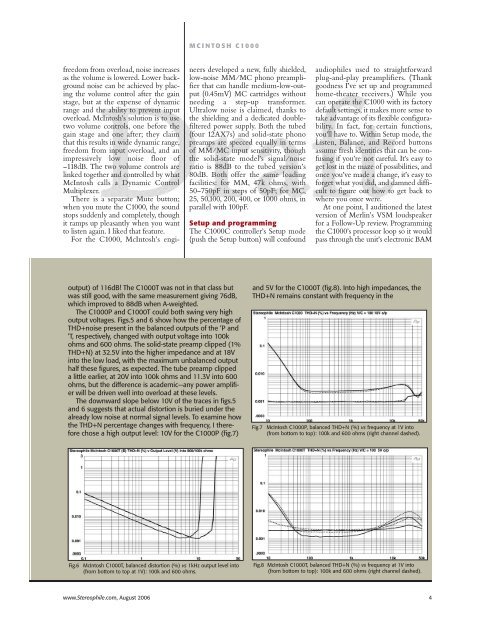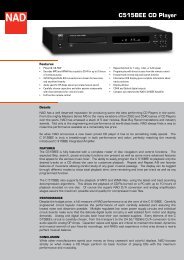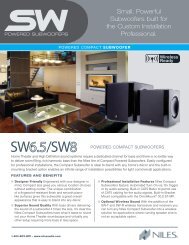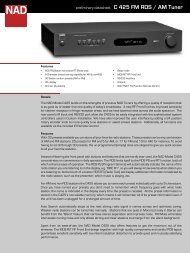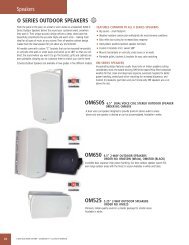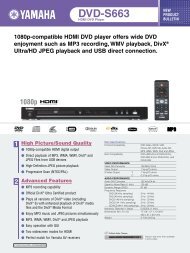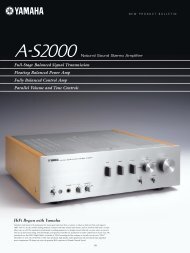McIntosh C1000 Stereophile Review - The Listening Post
McIntosh C1000 Stereophile Review - The Listening Post
McIntosh C1000 Stereophile Review - The Listening Post
Create successful ePaper yourself
Turn your PDF publications into a flip-book with our unique Google optimized e-Paper software.
MCINTOSH <strong>C1000</strong>freedom from overload, noise increasesas the volume is lowered. Lower backgroundnoise can be achieved by placingthe volume control after the gainstage, but at the expense of dynamicrange and the ability to prevent inputoverload. <strong>McIntosh</strong>’s solution is to usetwo volume controls, one before thegain stage and one after; they claimthat this results in wide dynamic range,freedom from input overload, and animpressively low noise floor of–118dB. <strong>The</strong> two volume controls arelinked together and controlled by what<strong>McIntosh</strong> calls a Dynamic ControlMultiplexer.<strong>The</strong>re is a separate Mute button;when you mute the <strong>C1000</strong>, the soundstops suddenly and completely, thoughit ramps up pleasantly when you wantto listen again. I liked that feature.For the <strong>C1000</strong>, <strong>McIntosh</strong>’s engineersdeveloped a new, fully shielded,low-noise MM/MC phono preamplifierthat can handle medium-low-output(0.45mV) MC cartridges withoutneeding a step-up transformer.Ultralow noise is claimed, thanks tothe shielding and a dedicated doublefilteredpower supply. Both the tubed(four 12AX7s) and solid-state phonopreamps are specced equally in termsof MM/MC input sensitivity, thoughthe solid-state model’s signal/noiseratio is 88dB to the tubed version’s80dB. Both offer the same loadingfacilities: for MM, 47k ohms, with50–750pF in steps of 50pF; for MC,25, 50,100, 200, 400, or 1000 ohms, inparallel with 100pF.Setup and programming<strong>The</strong> <strong>C1000</strong>C controller’s Setup mode(push the Setup button) will confoundaudiophiles used to straightforwardplug-and-play preamplifiers. (Thankgoodness I’ve set up and programmedhome-theater receivers.) While youcan operate the <strong>C1000</strong> with its factorydefault settings, it makes more sense totake advantage of its flexible configurability.In fact, for certain functions,you’ll have to. Within Setup mode, theListen, Balance, and Record buttonsassume fresh identities that can be confusingif you’re not careful. It’s easy toget lost in the maze of possibilities, andonce you’ve made a change, it’s easy toforget what you did, and damned difficultto figure out how to get back towhere you once were.At one point, I auditioned the latestversion of Merlin’s VSM loudspeakerfor a Follow-Up review. Programmingthe <strong>C1000</strong>’s processor loop so it wouldpass through the unit’s electronic BAMoutput) of 116dB! <strong>The</strong> <strong>C1000</strong>T was not in that class butwas still good, with the same measurement giving 76dB,which improved to 88dB when A-weighted.<strong>The</strong> <strong>C1000</strong>P and <strong>C1000</strong>T could both swing very highoutput voltages. Figs.5 and 6 show how the percentage ofTHD+noise present in the balanced outputs of the ’P and’T, respectively, changed with output voltage into 100kohms and 600 ohms. <strong>The</strong> solid-state preamp clipped (1%THD+N) at 32.5V into the higher impedance and at 18Vinto the low load, with the maximum unbalanced outputhalf these figures, as expected. <strong>The</strong> tube preamp clippeda little earlier, at 20V into 100k ohms and 11.3V into 600ohms, but the difference is academic—any power amplifierwill be driven well into overload at these levels.<strong>The</strong> downward slope below 10V of the traces in figs.5and 6 suggests that actual distortion is buried under thealready low noise at normal signal levels. To examine howthe THD+N percentage changes with frequency, I thereforechose a high output level: 10V for the <strong>C1000</strong>P (fig.7)and 5V for the <strong>C1000</strong>T (fig.8). Into high impedances, theTHD+N remains constant with frequency in theFig.7<strong>McIntosh</strong> <strong>C1000</strong>P, balanced THD+N (%) vs frequency at 1V into(from bottom to top): 100k and 600 ohms (right channel dashed).Fig.6<strong>McIntosh</strong> <strong>C1000</strong>T, balanced distortion (%) vs 1kHz output level into(from bottom to top at 1V): 100k and 600 ohms.Fig.8 <strong>McIntosh</strong> <strong>C1000</strong>T, balanced THD+N (%) vs frequency at 1V into(from bottom to top): 100k and 600 ohms (right channel dashed).www.<strong>Stereophile</strong>.com, August 2006 4


